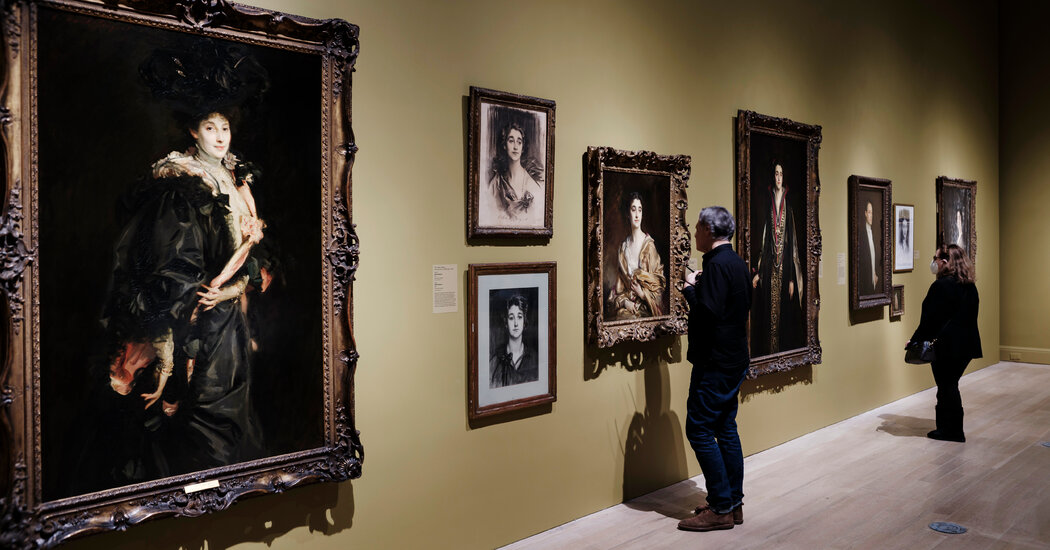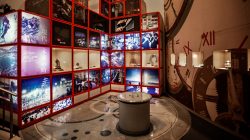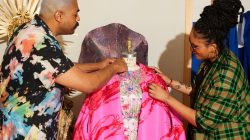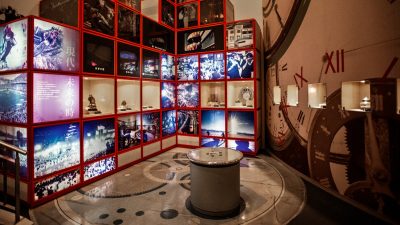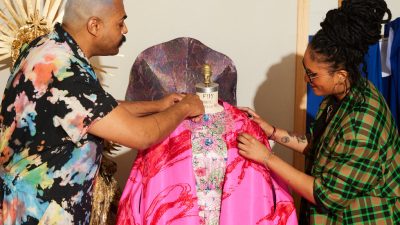If you worry your dining room table is too small for Passover, take heart: Your brood has a simpler seating chart than the Sassoons.
One of the richest merchant dynasties of the 19th and early 20th centuries, this Iraqi-Jewish family grew from local power players in the Middle East into some of the biggest machers of the imperial age, ramifying and reconstituting themselves in Asia and England. The Sassoons’ trading firm became one of the world’s first truly multinational companies, with numberless sons and daughters staffing its offices and spending its cash. Try to follow the “abridged” genealogical chart provided by the museum, with its interlocking axes of descendance and intermarriage, and you may rediscover the mercies of the nuclear family.
“The Sassoons,” opening this weekend at the Jewish Museum, is a panoramic survey of four generations of traders, socialites, soldiers and sybarites. Their lives and possessions — their ivories and porcelains, their prayer books and sketchbooks — map a century of forced migration, colonial expansion and absorption into high society. Several Sassoons were celebrities in their day, though their fame has faded. These days the family member most likely to draw attention is the war poet and London party animal Siegfried Sassoon, reanimated onscreen last year in Terence Davies’s melodrama “Benediction.” (The other famous Brit of the name, the hairdresser Vidal Sassoon, was unrelated.)
For more than a century, they have been stamped with the dumb misnomer “Rothschilds of the East.” The Sassoons claimed descent from the line of King David, and enjoyed great prominence in Baghdad until the 19th century. Yet their family narrative diverges in more important ways from those of Ashkenazi dynasties of finance and industry: the Rothschilds and the Reinachs, the Lehmans and the Guggenheims. The Sassoons were merchants, not bankers, and the Jewish Museum show stresses how closely their wealth — in cash, in art — grew and waned with that of the British Empire.
They spoke Judeo-Arabic and Hindustani before they spoke English. They circulated, first in desperation and later in high style, among four of the world’s great commercial and cultural capitals: Baghdad, Bombay (today Mumbai), Shanghai and London. They dealt in spices, pearls and also hard drugs; the Sassoon epic is one part “Buddenbrooks,” one part “Scarface.”
And they assimilated. When the Sassoons arrived in India, they staffed their trading posts with fellow Baghdadi Jews. Intricate ketubot (or marriage contracts) testify here to their endogamous unions. But later generations who settled in London married up and out, with Ashkenazis as well as gentiles; they remade themselves as British aristocrats, not all of them gifted in business. By the century’s end their wealth had dissipated, and recently several auctions have brought out treasures from the Sassoon past. Some Jewish ritual objects in this show were sold at Sotheby’s in 2020, and this spring the same auction house is offering the “Codex Sassoon,” a Hebrew Bible more than a millennium old, for something on the order of $30 million to $50 million.
The dynasty’s modern patriarch was David Sassoon (1792-1864), who like his ancestors served as treasurer to the pasha of Baghdad. When a new ruler took power in 1830, he and other Jews were expelled from Ottoman Iraq. After two years he arrived in the still somewhat ramshackle port of Bombay, where he began to trade in spices, fabrics, foodstuffs and jewels.
Deeply devout, David Sassoon earmarked a percentage of his firm’s profits for charity works, as well as the maintenance of Jewish sites back in Iraq. In a portrait of him here by a colonial British artist, he wears the turban and gown then favored by Baghdadi Jews. Rings glisten on both pinkies. But look at the sash around his waist: colorful, intricate South Asian paisley. Over his shoulder lies the gentle arc of Bombay’s Back Bay.
Sassoon and his children bought and also commissioned Jewish ceremonial art, such as two ornate gilt silver Torah finials, each topped with an open palm embossed with prayers. (They date to the early 1740s, and are among the oldest surviving Iraqi Judaica.) There’s an exquisite Haggadah, handwritten in Calcutta and festooned with Mughal-inspired illumination, whose pages tell the Passover story in both Hebrew and Judeo-Arabic.
Perhaps the most cosmopolitan objects in this show are two silver cases, for Torah and haftara scrolls, commissioned around 1890 by Flora Sassoon. Flora was David’s great-granddaughter (and later also his daughter-in-law; like I said, the family tree is gnarled), and she was one of the few women to take a leading role in the firm. The scrolls were copied by scribes in Baghdad; the cases are Chinese, with floral patterns without and within; and Flora worshiped with them first in Bombay and later in London.
The family’s transubstantiation of lucre into religious hardware was pretty brassy, because — not to put too fine a point on this — the Sassoons were drug kingpins. With the British victory over the Qing dynasty in the First Opium War (1839-42), China ceded the port of Hong Kong and opened Shanghai’s to foreign residency and trade: particularly trade in Indian opium, which the Sassoon firm delivered with their speedy clipper ships. It was opium that powered the Sassoons’ expansion across Asia, and by the 1870s they had cornered the narcotics market to a degree Pablo Escobar would envy. Have a look at an intricate ivory casket, its front face carved with Chinese hunters, its lid painted with ships plying the Pearl River. These Asian waterways were now arteries of a global economy. On their shores arose magazines of spices and silks; in their teahouses the affluent brushed past the addicted.
The narco money, and the entwining with British imperial interests, led the next generation of Sassoons to England, where they bought old art and new lives. Sir Philip, born to a Sassoon father and a Rothschild mother, became a member of Parliament, acquired paintings by Gainsborough, and hosted royalty at his Mayfair townhouse. His sister Sybil, who married a marquess and restored the palatial Houghton Hall in Norfolk, sat several times for John Singer Sargent, drenched in silk that resembles whipped butter. The paintings on view here that they owned are, I’ve got to say, no great masterpieces, and if you want splendor this show’s eastern Judaica may be more compelling. Yet their overt Anglophilia is a testament to the capaciousness of identity, to the back-and-forth desires of assimilation and distinction. Objects, as much as people, change their meanings and values as they migrate.
Along with Flora and Sibyl, this show’s other notable Sassoon woman is Rachel Beer (1858-1927). Born in Bombay, she edited The Sunday Times and The Observer in London in the 1890s (her husband, Frederick Beer, owned both titles), and she published a decisive scoop about the Dreyfus Affair. In a portrait here she appears wrapped up in satin: a challenge to all newspapermen to step up their fashion game. It used to hang in the house of Rachel’s nephew, Siegfried Sassoon, which he bought with a legacy after her death — a great mercy, as Siegfried’s father was disinherited for marrying a gentile. (Rachel was also cast out, for converting, though she had Frederick’s money.)
The show closes with Siegfried (1886-1967): the most famous and least Jewish of the Sassoons (he was brought up in the Church of England, converted to Catholicism, and often invoked Christ in his verse). He enlisted at the very start of World War I, and won the Military Cross for brave, perhaps even suicidal, exploits on the Western Front. Yet in the trenches he wrote poetry of bitter fatalism, and by the war’s third year he had grown so disillusioned he could not hold his tongue. The most extraordinary object in this exhibition is one of the smallest: the first draft of Siegfried’s “A Soldier’s Declaration,” scratched into a journal in the spring of 1917. “I have seen and endured the sufferings of the troops,” he wrote, “and I can no longer be a party to prolonging those sufferings for ends which I believe to be unjust.” Then he crossed out the last word, and made it: “ … evil and unjust.”
When The Times of London published Siegfried’s statement that summer, it could have occasioned an appointment with the firing squad. Instead, thanks to his friends’ interventions, the army board diagnosed a nervous breakdown and sent him to Craiglockhart Hospital in Edinburgh — where he would meet the younger poet Wilfred Owen, and would write some of the glummest of his war verse. Generations of British schoolchildren have since learned to recite them by heart: archetypical “English” poetry, by a scion of Baghdad and Bombay.
I didn’t love the movie “Benediction.” The Siegfried I still care for most is the one in Pat Barker’s 1991 novel “Regeneration,” her achingly raw exploration of masculinity and war trauma. What Barker saw in Sassoon was that the war had turned young men into history before they were old. In their room in Edinburgh, Siegfried tells Owen of a night in a trench, when even amid the flares and shells he felt he was already gone. “A hundred years from now,” the author has Sassoon say, “they’ll still be plowing up skulls. And I seemed to be in that time and looking back. I think I saw our ghosts.”
The Sassoons
Through Aug. 13. The Jewish Museum, 1109 Fifth Ave. at East 92nd St, Manhattan, (212) 423-3200; thejewishmuseum.org.
Sumber: www.nytimes.com
